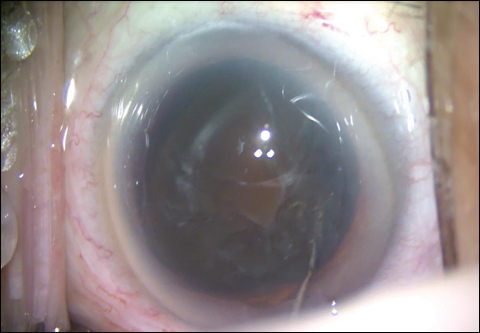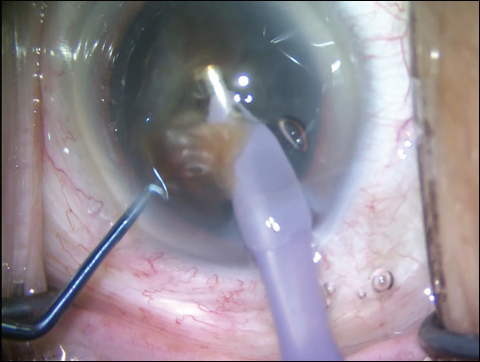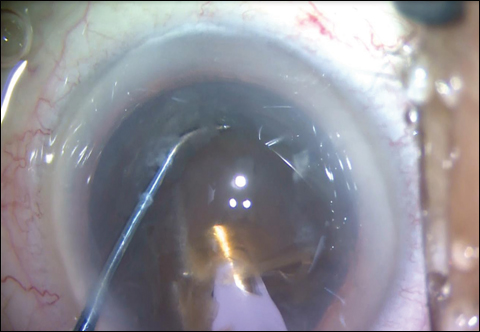Approach to the dense brunescent cataract
Even expert surgeons may face challenges when treating and restoring vision in these patients.
Patients with dense brunescent cataracts have typically delayed having cataract surgery for many years. During this time, the nuclear sclerosis progresses to the point where it causes additional challenges and poses higher risks for complications. For some patients, fear is the reason why they keep postponing surgery, whereas for others, lack of access to health care is the primary problem. With a careful approach and modified techniques, we can perform safe cataract surgery and restore vision to these patients.
Preoperative consultation
Often, other ocular comorbidities are present in these patients. The visual deprivation from the cataract can induce a sensory exotropia, particularly if one eye has significantly worse vision than the other. As the nuclear sclerosis progresses, the crystalline lens can increase in anterior-posterior dimension, which can lead to shallowing of the anterior chamber and narrowing of the angle. Sometimes a brunescent cataract, particularly if it is unilateral, can be associated with prior trauma or previous ocular surgery such as a pars plana vitrectomy.
Optical coherence biometry can usually measure the axial length in these eyes, but in cases in which the cataract is just too opaque, A-scan ultrasound may be required. The pupillary dilation should be measured because a sufficiently large capsulorrhexis will be needed during cataract surgery. The brunescent cataract can also induce a myopic shift in the refraction, so a discussion of the intended postoperative refractive target should be included in the consultation. Finally, patients should understand that their specific type of cataract does pose additional surgical challenges and risks. The increased amount of ultrasound used during phacoemulsification of a brunescent cataract will induce more corneal edema and delay visual recovery.
Intraoperative techniques
Anticipate that surgery for a dense brunescent cataract will take longer than a typical case, and consider supplementing the anesthesia. These cases can still be performed with topical and intracameral anesthesia, but care should be taken to keep the patient comfortable and pain-free. Using additional local anesthesia midway through the case can be helpful. For more challenging cases, a peribulbar or retrobulbar block may be helpful.
A standard limbal or corneal phaco incision can be used in these cases, but consider a scleral tunnel if you anticipate that there is a chance that you will need to convert to a manual extracapsular extraction. Because more ultrasound phaco energy will be used to emulsify the cataract, the risk for a phaco wound burn is increased. This can be mitigated by having a slightly leaky incision, floating in the center of the incision instead of pressing on the corneal tissue, and by using phaco power modulations. Phaco power modulations such as a variable duty cycle, pulse and burst modes, and torsional ultrasound delivery can all assist in keeping the cumulative energy relatively low and the phaco tip cooler.
A generous capsulorrhexis should be made with a diameter of about 5 mm to 5.5 mm to allow easy access to the cataract. In a routine case with only moderate nuclear sclerosis, there is a smaller endonucleus with increased density surrounded by a zone of softer epinucleus and then cortical material. However, in a brunescent cataract, the entire nucleus is dense with essentially no epinucleus, and this requires a larger capsulorrhexis to facilitate cataract extraction. If the red reflex and visibility are hindered by the brunescent cataract, trypan blue dye can be used to stain the anterior lens capsule.

Source: Uday Devgan, MD

Some surgeons may attempt to use a femtosecond laser to help fragment or soften the lens nucleus, but penetration of the laser energy depends on the opacity of the cataract. The brunescent cataract tends to be fibrous or leathery, particularly at the posterior portion of the lens, and this can make it difficult to cleave into distinct nuclear pieces. Some surgeons use mechanical devices, such as lassos or sharp cleaving instruments, to split the cataract before phacoemulsification.
The brunescent cataract typically has a dense, fibrous posterior plate that is difficult to split with traditional techniques such as divide-and-conquer or horizontal chop. My preferred technique involves partially prolapsing one part of the nucleus above the capsulorrhexis edge in order to place the chopper behind the posterior pole of the cataract (Figure 1). This can be done by gentle hydrodissection, although care must be taken to avoid blowing out the posterior capsule, or by placing the chopper around the lens equator and lifting the cataract up out of the bag.
Once the nucleus is partially prolapsed, dispersive viscoelastic is injected between the cataract and the posterior capsule and then again to recoat the corneal endothelial surface. The chopper is placed directly behind the posterior pole of the cataract while the phaco probe is embedded into the anterior portion of the cataract. The two instruments are then brought together and then pulled in opposite directions to cleave the cataract into two halves (Figure 2). Each half can then be subdivided into smaller pieces by further chopping (Figure 3). As pieces of the nucleus are cleaved and then phaco-aspirated, additional viscoelastic can be used to recoat the corneal endothelium. When the last nuclear piece is being removed, the smooth side of the chopper can be placed under the phaco tip to ensure that the posterior capsule is kept at a safe distance. Once the cortex is removed, the IOL is inserted into the capsular bag and centered with the capsulorrhexis overlapping the optic edge for stability (Figure 4).


Postoperative course
These patients are expected to have a longer postop recovery period due to the larger amount of phaco energy used in removing the dense brunescent cataract. Additional steroids may be helpful in reducing inflammation and aiding the cornea in resolution of any induced edema. After the eye has healed, these patients are incredibly happy because the improvement in vision is so dramatic. Dense brunescent cataracts are challenging, even for the expert surgeon, but with careful planning and a stepwise approach, they can be successfully treated and vision can be restored to our patients.
- For more information:
- Uday Devgan, MD, is in private practice at Devgan Eye Surgery, Chief of Ophthalmology at Olive View UCLA Medical Center and Clinical Professor of Ophthalmology at the Jules Stein Eye Institute, UCLA School of Medicine. He can be reached at 11600 Wilshire Blvd. #200, Los Angeles, CA 90025; email: devgan@gmail.com; website: www.DevganEye.com.
Disclosure: Devgan reports no relevant financial disclosures.
